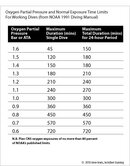I'm about to do a Nitrox course with PADI, unfortunately it appears there is no Advance EAN teaching here on the Island, I have set both of my DC to 1.5 PPO a notch above the coservative 1.4 PPO, looking at IANTD courses the EAN course is set to allow divers to reach 39m depth, but it doesn't mention the amount of exposure of PPO, in their Advance EAN course they mention 1.5 PPO and 42m Depth and state that you need to have taken the EAN and Deep Specialty with them it doesn't say "equivalent".
My question is that looking at both of my DC, with the 1.4 PPO you can't reach 39m with 32% EAN, with 1.5 PPO my DC's allows me 35.5m Depth, is IANTD using other non conventional mixes ( 32 and 36% ) to reach 39m depth with as well 1.5 PPO exposure for there EAN course ???
IANTD, will not allow me to take "Advance EAN" with them if I don't take thier EAN and Deep speciality courses or will they accept Deep Speciality and EAN with other Agencies ( since there is no mention of "Equivalent" courses ) ???
Any one that had taken the IANTD and PADI as well ???, it seems that they are very different since their depth's limitations of each agency course programs are not the same, any hints on this ???




